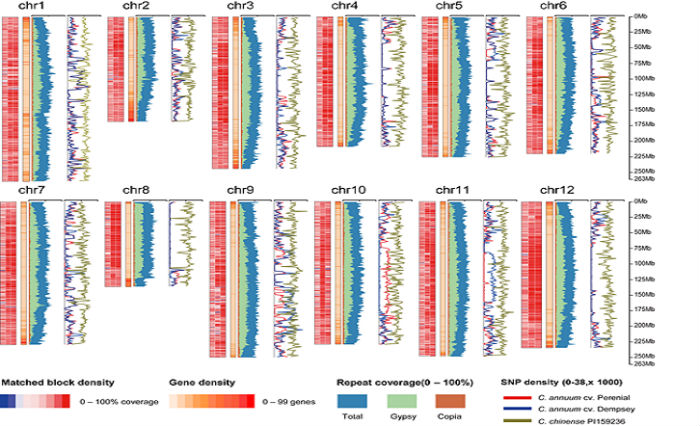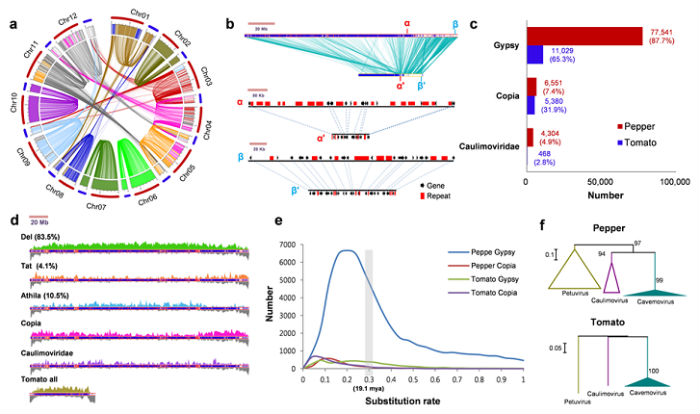-
 Korea.net's 24-hour YouTube channel
Korea.net's 24-hour YouTube channel- NEWS FOCUS
- ABOUT KOREA
- EVENTS
- RESOURCES
- GOVERNMENT
- ABOUT US
The secret of the chili pepper’s hot taste has been unveiled. The Rural Development Administration (RDA) recently announced that it has finished a complete analysis of the chili’s gene sequence using homegrown technology and has identified the “spicy” chromosome.
The analysis was conducted by a gene research team led by Professor Choi Doil of Seoul National University as part of the RDA’s so-called “Next Generation Bio Green 21” project (unofficial translation).

Researchers analyzed the base sequence of the chili pepper’s complete DNA sequence. It found that a chili has more genes than a human. Chilies have as many as 3,500 base pairs, four times more than other genetically-close vegetables like tomatoes or even potatoes.
The research found that both chilies and tomatoes have genes that create a “hot” taste but that the chili’s unique spiciness originates from its capsaicin. Capsaicin gives chilies their heat or pungency and it is made in the last part of the biosynthetic pathway that genetically distinguishes tomatoes from chilies.


This is the first time for a Korean institution to carry out a gene base sequence analysis of a plant using domestic technology. The results were released in an online edition of Nature Genetics, one of the most prestigious life science research publications worldwide, published on January 19.
The RDA said that this research will enable the production of high quality chilies that will be resistant to epidemics or anthrax. The organization added that the gene base sequence analysis technology can be applied to, and allow further research into, other solanaceous vegetables or to other similar species such as tomatoes, potatoes or eggplants.
By Yoon Sojung
Korea.net Staff Writers
arete@korea.kr
The analysis was conducted by a gene research team led by Professor Choi Doil of Seoul National University as part of the RDA’s so-called “Next Generation Bio Green 21” project (unofficial translation).

The RDA recently announced that it has finished its gene base sequence analysis of the chili using homegrown technology.
Researchers analyzed the base sequence of the chili pepper’s complete DNA sequence. It found that a chili has more genes than a human. Chilies have as many as 3,500 base pairs, four times more than other genetically-close vegetables like tomatoes or even potatoes.
The research found that both chilies and tomatoes have genes that create a “hot” taste but that the chili’s unique spiciness originates from its capsaicin. Capsaicin gives chilies their heat or pungency and it is made in the last part of the biosynthetic pathway that genetically distinguishes tomatoes from chilies.

The outline of the analysis of the chili pepper’s 12 chromosomes

A comparison of the gene base sequence of tomatoes and chilies (Images courtesy of the RDA)
This is the first time for a Korean institution to carry out a gene base sequence analysis of a plant using domestic technology. The results were released in an online edition of Nature Genetics, one of the most prestigious life science research publications worldwide, published on January 19.
The RDA said that this research will enable the production of high quality chilies that will be resistant to epidemics or anthrax. The organization added that the gene base sequence analysis technology can be applied to, and allow further research into, other solanaceous vegetables or to other similar species such as tomatoes, potatoes or eggplants.
By Yoon Sojung
Korea.net Staff Writers
arete@korea.kr
Most popular
- First hearing-impaired K-pop act hopes for 'barrier-free world'
- Event 'K-Beauty Hang Out' draws hundreds in Philippines
- Ceremony in Seoul inducts 2,641 content creators of Korean culture
- 'Mad Max' director impressed by 'cinema-literate' Korean viewers
- Cultural spring festival Seoul Festa to start on May 1













